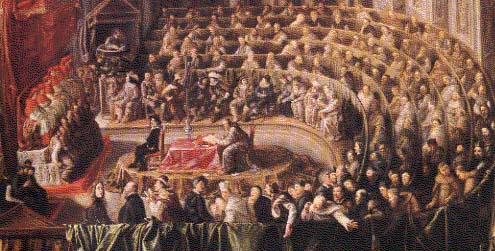The Trial of Fatinelli
During the Middle Ages, the scientific study of vampirism was tangled up in religious notions of good versus evil. Vampires were the Devil's foot soldiers, and victims of vampirism were thought to have had some sort of moral failing which left them vulnerable to attack. The large number of prostitute-victims was held up as proof of this. The church, at perhaps the zenith of its power, had a vested interest in keeping this notion afloat, as nervous worshipers tended to spend more time in church and give more money. But the dawn of the Renaissance gave rise to a number of visionary scientists who, at their own peril, began to question previous assumptions about vampirism. And one of them, an Italian named Ludovico Fatinelli, paid for it with his life.
 |
| Ludovico Fatinelli |
Fatinelli was a native of Florence whose father was employed in the relatively new profession of making eyeglasses. The young Fatinelli took an interest in his father's trade and made his own magnifying glasses to study the world around him. As his lenses got more sophisticated, he was able to discern a world previously unknown to science. His notes from a look at a sample of water from the Arno River capture the excitement of discovery: "I then saw, with great wonder, that in the water were very many little animalcules, very prettily a-moving. The animalcules were in great number, and oft times spun around like a tail." Fatinelli had taken the first recorded look at bacteria.
 |
| The trial of Fatinelli |
The young Florentine went on to study medicine at the University of Padua, where one of his teachers was the great scientist and philosopher Galileo Gallilei. While there, Fatinelli, through the use of increasingly more sophisticated microscopes, discovered that "animalcules" also appeared to live in human tissue. From these observations, the young scientist developed the radical theory that it was these microscopic entities, not moral failures, that were the real source of vampirism. Experiments on animals seemed to bolster his hypothesis, and he set to work on a treatise that would summarize his findings and, he hoped, establish his reputation as a great scientist.
 |
Florence's Piazza
Signoria the morning
of Fatinelli's execution |
In Januay, 1616, Fatinelli published his findings under the title, Treatise on Vampires. Alas, his timing couldn't have been worse. Pope Paul V, worried about the rise of Protestantism, had been taking a hard line against any new interpretation of church dogma and decided to make Fatinelli an example. The young man was brought up for the Inquisition, and when he refused to recant the conclusions in his treatise, he was charged with heresy and brought to trial. Though a simple recantation probably could have gotten him off the hook, Fatinelli stood behind his findings. Judgment was swift: the verdict was guilty, the sentence, death.
On April 23, 1616, a huge crowd gathered in Florence's Piazza Signoria to witness the execution. Fatinelli was tied to a pole atop a pile of logs, which were then set ablaze. The fire ate through the rope securing Fatinelli to the pole, and his left arm flew up in the air. A shriek went through the crowd; many fainted, thinking that the Devil was passing a curse from Fatinelli's body onto them. But the man on the pyre was only flesh and blood. Once the spectacle was over, one of the most important scientists of the time was ignominiously heaved into a pauper's grave, where the church hoped he would be forgotten forever.
It was not to be. Though Fatinelli was gone, his research lived on. For years after his death, illicit copies of his banned treatise made their way through Europe's scientific communities and helped pave the way for important work by scientists like the Englishman Edward Jenner, who created the first vaccine in 1795. Fatinelli had indeed been far ahead of his time: too far ahead, for the church's comfort.
© 2001-2014 Dango Productions, Inc.






